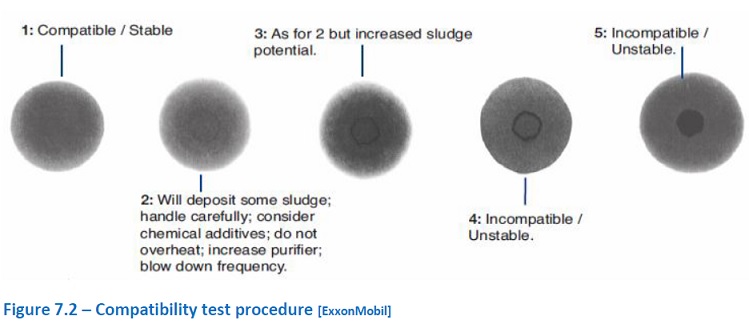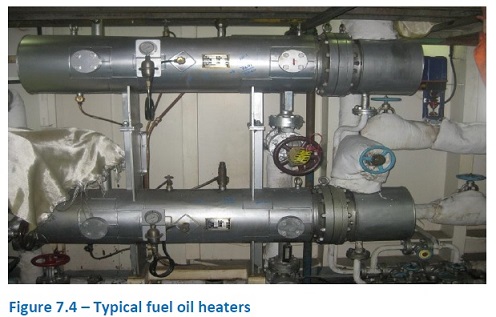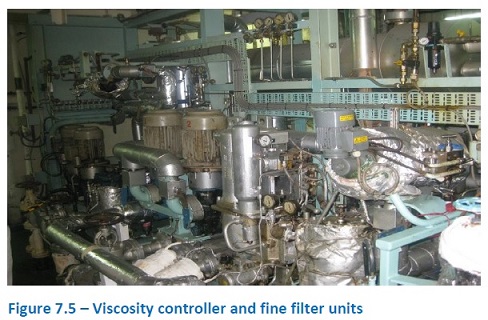Fuel quality has a significant impact on engines' and boilers reliability and performance. When ordering fuel, qualities such as the grade of fuel, its specification, calorific value, and suitability for engines and boilers need to be considered. It is well known that higher density fuels and higher water and sulfur contents all reduced calorific value that represents the energy content of the fuel. Also, high sulfur contributes to undesirable air emissions of SOx and high metallic impurities put the engines and boilers at risk.
The limits for fuel quality parameter as set out in International marine fuel standard, ISO 8217, is based on the understanding that the fuel will be treated on-board the vessel to meet specific requirements for particulars of engines and boilers fitted on-board the vessel. On-board treatment systems are therefore vital in ensuring that fuel is purified effectively to ensure it complies with the necessary specifications of the relevant combustion system.
This webpage covers aspects of fuel management, including bunkering, fuel quality analysis, storage, and treatment. It starts at bunkering point and ends when fuel is supplied to various combustion systems including engines, boilers, etc.
Fuel oil procurement and bunkering
The first major step in fuel management is to ensure that the right quality of fuel is ordered for the vessel. While requesting bunkers for a specific vessel, any limitations of ship's machinery capabilities, limitations on storage, operation profile, trading area for environmental compliance and giving enough time to get analysis before the fuel is put into use, should be considered.
The on-board fuel management starts first with the bunkering operation. During the bunker operation, safe handling and pollution prevention control measures, correct measurements before, during, and after bunker operations, loading in empty tanks (to avoid mixing of incompatible fuels), and collection of representative samples are the most critical issues. Quantity (by weight) of fuel bunkered should be established and recorded along with the on-board storage locations and tracked to ensure selection of good subsequent heating or purification characteristics.
Quantity calculations aside, taking a representative sample(s) of the fuel delivered to the vessel is a regulatory requirement and is of paramount technical and commercial importance for the safety of engines and boilers. Without adherence to correct sampling procedures, which give a real insight into the quality of fuel loaded by the vessel, the analysis results provided may be flawed. Analysis of fully representative samples of each bunker batch serves as the first line of defense against poor quality fuels. Such an analysis should be performed to assure the quality of fuel supplied and to identify potential problems at the earliest opportunity, which helps identify mitigating actions/claims that may arise due to the supply of poor quality fuels.
Fuel quality and quantity assurance
Bunkers come in a wide variety of quality levels and to meet the international quality standards (ISO 8217) and statutory requirements (mainly sulphur), the marine residual fuels are generally blended by manufacturers or suppliers with different components. Using better quality fuel and /or a higher grade of fuel can lead to an improvement in engine efficiency, safety of combustion systems and / or prevent degradation. On the other hand, to meet the regulatory requirement to reduce the sulphur level in bunker fuel, more and more refinery processes and also blend components are being used which could results in an increase in the levels of highly abrasive particles of Aluminium and Silicon (also called catalytic fines) or fuel’s chemical stability over the long term. This has also raised concerns about the ignition and combustion quality of fuels along with the issues related to the stability and compatibility of the fuels.
Thus analysis of the representative sample(s) of the bunkered fuels should be carried out to ensure:
- Appropriate storage, handling and treatment actions are taken beyond bunkering up to consumption.
- The use of fuel in a most safe and efficient way.
- Compliance to environmental legislation.
- Maximise combustion performance.
- Appropriate actions are taken to avoid any adverse effects and mitigating disputes.
- Reduce commercial, technical and operational risks associated with using varying quality fuels.
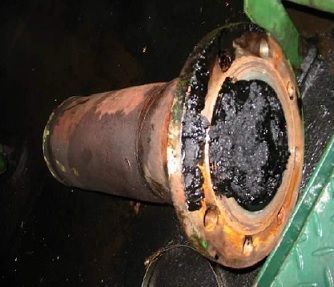
Clogged fuel pipes
Figure 7.1 : Clogged fuel pipes due to very poor quality fuels
Fuel storage and transfer
It is important that all precautions to be made to try to avoid co-mingling (i.e. loading on top of each other) of different batches of fuels. Incompatible fuels are the most common problem with the bunker fuel mixing that leads to clogged filters and in the worst case scenarios, complete paralysis of the fuel system lines as shown in Figure 7.1. This also helps in case the fuel supplied is of undesired quality then co-mingling makes it difficult to de-bunker the fuel if such situation arises.
If the mixing of the fuels is unavoidable due to bunker planning and operational reasons, then this should be done after performing the compatibility test between the fuels to be mixed that would indicate their stability after mixing. Ideally, such a test should be carried out under lab conditions however this test can be carried out on-board the vessel as illustrated in Figure 7.2.
Figure 7.2 – Compatibility test procedure [ExxonMobil]
Fuel should be consumed in a first-in, first-out fashion. Avoid carrying or use fuels that are over a few months old. The longer a fuel is kept on-board, the chances of sediments in the fuel to drop out and stratification of the fuels increase. It then leads to more potential for filter clogging and other fuel issues and problems. The fuel that cannot be used for any reasons should be de-bunkered off the ship as soon as possible in consultation with vessel's technical superintendent.
Bunker measurements
Bunker measurement is normally carried out before and after bunkering by the chief engineer or his/her representative to ensure that the quantity of lifted bunkers is accurate. The method of measurements includes:
- Manual gauging of fuel tanks before and after bunkers:
It, together with making corrections for the trim/heel of the vessel, gives the volume of the fuel in the tanks, which are then subtracted from the pre-bunker readings. Using the fuel volume, temperature, and the fuel supplier's density, and by applying a correction factor for the observed temperature, the weight of the fuel is calculated. This calculation is based on the understanding that the density of the fuel given by the supplier is correct. Also, there is no excess water in the fuel. This weight is adjusted according to upon receipt of the bunker drip sample analysis if the fuel's density varies considerably from the reported values or the amount of water in the fuel is excessive.
- Use of the mass flow meters: Based on the performance of the available technologies, Coriolis mass flow meters are advocated to be a good choice for mass flow metering of the fuel during bunkering because of the direct mass measurement by this device. Manufacturers claim that such measurements are not affected by fuel temperature, pressure, and composition. Meter size and location of the meter plays an important role therefore proper installation and operation practices are critical for these meters.
Of the above methods, the use of Coriolis flowmeters is still being investigated and tested in the field to ensure optimal performance and benefit these types of flow meters. Currently, option one above that involves fuel inventory check is the common practice in industry.
Fuel consumption measurement and reporting
Fuel consumption of main engines, auxiliary engines, and boilers is normally measured and recorded daily. These are recorded in the engine logbook and reported to the company through noon reports and voyage reports. Method of daily fuel consumption measurement is done as follows:
- By the use of mass flow meters fitted for main engines, auxiliary engines and for the boilers.
- Manual gauging of the tanks and measuring the number of fuels transferred to the specific machinery type.
The accuracy of fuel flow meters is of great importance. For energy efficiency monitoring, the vessel should be able to accurately measure the amount of fuel consumed on-board by the main consumers. It includes a thorough understanding of the fuel system and the placement of accurate fuel flow meters on the system, which must have reasonable accuracy. Furthermore, the fuel oil temperature at the flow meters should be measured and related correction made from normally measured volumetric flow rate to mass flow rate. It is best if the accuracy of the fuel flow meters is regularly verified.
Fuel oil treatment – Settling and purification
Settling tank(s)
The settling tank's role is to separate heavy residues and water from the fuel through the natural settling process. In this way, these items are expected to settle gradually at the bottom of the settling tank. To provide the best performance:
- Settling tank temperature should normally be maintained between 60-70C for HFO to reduce the density and viscosity of the fuel to facilitate gravitational separation.
- Transfer of fuel to the settling tank to be controlled automatically to top up in small quantities at frequent intervals. It helps minimize the temperature drop and quantity of dirty/unsettled fuel in the tank immediately after the transfer.
- It is important to drain off water and sludge at the settling tank bottom drains at regular intervals. Frequent/low volume – "flash blowing" is the most effective way of removing settled contaminants.
- Some settling tanks are fitted with high and low outlets. In normal service conditions, it is always preferable to use the lower outlet to minimize the space available for sludge accumulation and give early warning of contamination issues. The high outlet should only be used when there are major issues such as when the tank is subject to a significant water contamination.
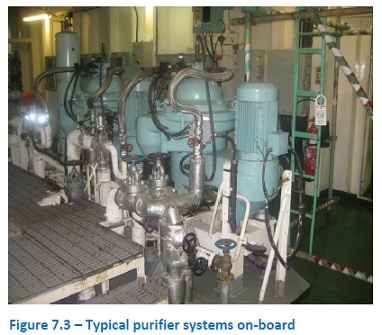
Fuel purification
Purifiers are almost invariably used in ships. The main task of purifiers is to separate water and other impurities from fuel. The purification process is based on centrifugal motion principle and the fact that materials with different densities will be subject to different centrifugal forces and thereby will separate from each other. Figure 7.3 shows the typical arrangement of fuel oil purifiers on board ships.
The efficiency of a centrifugal separator is affected by several factors such as composition of the fuel (nature, quantity and size of undesired components), unstable process fluid dynamics (homogenisation of the fuel before the separators, turbulence within the fuel, poor temperature stability of the process fluid), cleanliness of the separator (the gap between individual discs in the disc stack, fouling of the clean fuel centripetal pump, fouling of the control water system or sliding bowl parts) and general operation (separator throughput, incorrect discharge interval).
For good purifier performance, the following operating controls should be observed:
- Operate purifiers / clarifiers in an optimum manner with purification level dependent on contaminant levels.
- Where applicable, ensure correct gravity disc fitted to purifiers. Manual de-sludge cycle time should be set with regard to fuel contaminant levels.
- In order to optimise the volume available within the bowl the interface line should be as close to the edge of the separating disc as possible.
Sludge (oil residue) is considered to be the residual waste oil products generated during the normal operation of a ship, such as those resulting from the purification of fuel or lubricating oil for main or auxiliary machinery, separated waste from oil filtering equipment, waste oil collected in drip trays and waste hydraulic and lubricating oils.
Excessive sludge from the fuel oil system such as purifiers is a parameter that reduces the fuel efficiency of the ship via increased fuel waste. As a result, the monitoring of the fleet’s sludge production in relation to the fuel consumption, with the aim of promptly identifying cases where corrective actions are needed is quite important. Some ships will benefit from use of fuel homogenisers to reduce sludge
Fuel viscosity control
For use of fuels in engines it is very important to ensure that the fuel is heated to the correct temperature to maintain the required injection viscosity at the engine inlet. Incorrect injection viscosity results in poor atomisation which affects the efficiency by which the fuel is burnt.
Figure 7.4 shows the fuel oil steam heater for control of fuel oil temperature. The arrangement of viscosity controller and fuel filters are shown in Figure 7.5.
Figure 7.4 – Typical fuel oil heaters
Figure 7.5 – Viscosity controller and fine filter units
It is best to put the viscosity controller on auto viscosity control mode than on the fixed temperature control mode. The correct function of the viscosity controller should be ascertained when changing from high viscosity fuels to low viscosity fuels and vice versa.
Due to the complex nature of marine residual fuels, it is difficult to predict the ignition and combustion performance of two fuels, even if their standard quality parameters are the same. Poor quality fuels may lead to significant damages to the engine. Given this, it is good practice to monitor the engine's cylinder combustion performance through available diagnostic tools on-board, particularly when using a new bunker.
In case of any issues with the ignition/combustion of the fuels, appropriate actions should be taken to keep the engine parameters within the specified limits. Engines fitted with VIT (Variable Injection Timing) or similar arrangements can be adjusted accordingly to enhance the ignition/combustion efficiency.
Fuel oil additives
Fuel additives are chemical compounds formulated to enhance the quality and efficiency of the fuels used. Environmental legislation to reduce emissions and improve fuel economy has a significant impact on fuel formulations and engine system design. As a result of low sulfur regulations, the composition, long term stability, lubricity, combustion quality, etc. of fuels are evolving due to either de-sulphurization of heavy fuel oil or blending. Fuel contamination with bio-related products mixed with fuels adds a new dimension to fuel's long term stability.
Typical types of additives are metal deactivators, corrosion inhibitors, oxygenates, and antioxidants. Fuel additive suppliers advocate for them to deliver flexible and advanced solutions to the ever-changing fuel market environment and fuel quality issues. Over many years, additive products have demonstrated benefits in some specific areas of marine applications.
The fuel additive technology could provide benefits for marine fuels, mainly in areas of enhancing fuel combustion and preventing the formation of particulates (combustion enhancing additives). The same additives also help prevent fouling of exhaust systems and economizers as well as provide a cleaner combustion system altogether. Therefore, it may be stated that additives have proven records concerning:
- Improvement of fuel combustion and reduction of particulate matter and visible smoke.
- Overcoming soot build-up in the exhaust system, thus ensuring the efficiency of the exhaust system including economizer by keeping them clean and foul free with a reduction in risk of fire.
- Reduction and inhibition of deposit build-up on piston rings, injector nozzles, and valves.
- Reduction and prevention of cylinder liner lacquering build-up.
- Protection against fuel pump and injector needle seizures commonly associated with ultra-low sulphur fuels.
- Extension of engine maintenance intervals and less engine downtime; saving both time and money.
The impact of fuel additives on engine fuel efficiency has not been proven despite some significant claims made by some suppliers. However and because of the better combustion efficiency and cleaner engine and exhaust system, some improvement in engine thermal efficiency is expected; but not significant.
Various fuel oil additives are available on the market. The use of additives, being chemicals, should take place with care and after full testing and consultation with engine manufacturers. Also, the right dosage at distinct periods should be observed. Also, treatment of fuel oil should be carried out following manufacturer's advice to ensure optimum performance from the combustion of fuel.
Energy efficiency measures
There are several energy efficiency measures directly related to the fuel management aspect. These measures include:
- Vessels should carry the most economical amount of bunker in inventory. Carrying too much bunker fuel is not energy efficient as they have weight, and any extra weight transport will cause extra fuel consumption.
- Energy is also used for temperature control of fuel and its transfer.
For energy-efficient storage and transfer, fuel temperature in storage tanks needs to be controlled to the lowest possible temperature. It is to retain it in a running condition and also suitable for transfer. In the latter case, only the fuel is to be transferred, which is to be heated. Steam heating and trace heating should only be applied as required and not be left running unnecessarily.
- Ensure tank fittings (manhole covers, vent pipes, etc.) do not allow water, cargo, or other material to get into the fuel. Ensure that heating coils are tight.
- Ensure that tank wall condition is in good order, thus avoiding corrosion or other material being entrained with the fuel, which then has to be removed.
- Maintain settling tanks at a temperature which will enable the purifier heaters to achieve the required treatment temperature.
- When a service tank is not in use, it is not necessary to maintain usual high temperatures.
- Heater controls should be checked to ensure correct operation. Accumulations on heater elements should be minimized.
- Periodically verify that the viscosity controller is working correctly.
- Monitor fuel oil sludge levels and ensure that sludge levels are not high due to poor maintenance of the purifiers. As advocated, homogenizers can be used to reduce the sludge levels.
Fuel measurement and metering is the first step for subsequent performance analysis of various engines and boilers. The more accurately fuel consumption is measured and reported, and the more will be the chances for identifying inefficiencies and making improvements.
Although all aspects of fuel management have a close association with energy efficiency, most of the shipboard activities are done to safeguard the engines and boilers from damage. Therefore, fuel management for the safety of assets marries well with its aspects of energy-saving, and there is no conflict between the two objectives.
References and further reading
The following list provides references for this section and additional publications that may be used for more in-depth study of topics covered in this section:
1. "IMO train the trainer course material," developed by WMU, 2013.
2. ExxonMobile Newsletter, “Fuel stability and compatibility - best practise top tips” http://www.exxonmobil.com/MarineLubes-En/learning-and-resources_voyager-newsletter_2015_may.aspx
3. Dimitrios V. Giannakouros, "Technical Aspects of Identifying and Managing Bunker Problems," Presentation to the Marine Club (West England), November 2012, http://www.westpandi.com/globalassets/loss-prevention/loss-prevention-seminars/121108-technical-aspects-of-identifying-and-managing-bunker-problems.pdf
4. Gard 2014 "Bunkers and Bunkering," A selection of articles previously published by Gard AS, http://www.gard.no/
Read more on
Energy efficiency measures -Trim optimization
Energy efficiency measures- Ballast water management
Energy efficiency measures- Causes of Hull roughness and preventive measures
Energy efficiency measures- hull roughness reduction
Energy efficiency measures- propeller maintenance
Energy efficiency measures- engine load management
Energy efficiency measures- fuel management
Energy efficiency measures - ship maintenance requirement
Related articles
Oil spillage prevention procedure
Pollution by other harmful substances & harmful packaged goods
Pollution by garbage [ Marpol annex V ]
Pollution by sewage [ Marpol annex IV ]
Pollution of air [ Marpol annex VI ]
Prohibition on use of harmful (TBT) anti-fouling paints
Pollution by ballast water
Prevention of pollution while carryiung out overboard maintenance
Environment friendly purchasing
Decommissioning / ship recycling
Environmental awareness

Other info pages !
Ships Charterparties Related terms & guideline
Stevedores injury How to prevent injury onboard
Environmental issues How to prevent marine pollution
Cargo & Ballast Handling Safety Guideline
Reefer cargo handling Troubleshoot and countermeasures
DG cargo handling Procedures & Guidelines
Safety in engine room Standard procedures
Questions from user and feedback Read our knowledgebase
Home page

ShipsBusiness.com is merely an informational site about various aspects of ships operation,maintenance procedure,
prevention of pollution and many safety guideline. The procedures explained here are only indicative,
not exhaustive in nature and one must always be guided by practices of good seamanship.
User feedback is
important to update our database. For any comment or suggestions please Contact us
Site Use and Privacy - Read our privacy policy and site use information.
//Home //Terms and conditions of use
Copyright © 2015 www.shipsbusiness.com All rights reserved.




